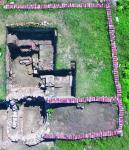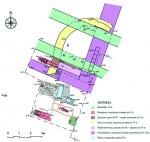Summary (English)
NOVAE (Pavlina Vladkova – pavlina_v@yahoo.com) The excavations continued in Sector VIIIA extra muros. Strata from the 2nd to 6th centuries AD were documented. A leveling layer was discovered beneath the Christian basilica of the 6th century AD; its floor was built over this. Four graves were discovered in the Christian necropolis of AD 475 – 500, situated beneath the floor of the nave of the basilica. The body in Grave No. 4 was laid to the north of the southern wall of the tablinum; a lead stand for wooden cross was discovered to the right of the skull. Walls of the 5th century AD, 80 cm wide, were documented in the northern part of the nave of the basilica; a brick in the wall had a stamp with the name of a private producer: ALEX. Part of a curved wall of piscina was documented in the northern aisle of the basilica. The wall was 65 – 70 cm wide, built over the ruins of the tablinum; the lowest course of its foundations was constructed of bricks from the hypocaust of an earlier building. The southwestern corner of the tablinum was situated beneath the nave and the northern aisle of the basilica. The tablinum was built after AD 176 and existed with some reconstructions until AD 375 – 400. Sectors of its eastern and western walls were explored, 1.45 m wide and plastered with mortar. A coin of Constantine the Great was found there. The floor was plastered with mortar and a collapsed burned roof was documented on it. Some of the roof-tiles had stamps that read: LEG I ITAL and LEG I ITALI. The pilae of the hypocaust were terracotta pipes or were built of bricks. The southern wall of the tablinum was built over the foundations of an earlier wall and probably had an entrance with a wooden door, since burned iron nails and clamps were found. A wall, 50 cm wide, belonging to an earlier building of AD 100 – 170 was discovered close to the southern wall of the tablinum. A drain was excavated. It was 24 cm wide, its walls were built of cut stones, its bottom was paved with imbrices and it was covered with bricks, some of them with stamps of Legio I Italica.
- Pavlina Vladkova - Regional Museum of History – Veliko Tarnovo
Director
- Pavlina Vladkova - Regional Museum of History – Veliko Tarnovo
Team
Research Body
- Regional Museum of History - Veliko Tarnovo






![Download [PDF]](/excavation/skins/fasti/images/results/download_sml.png)
